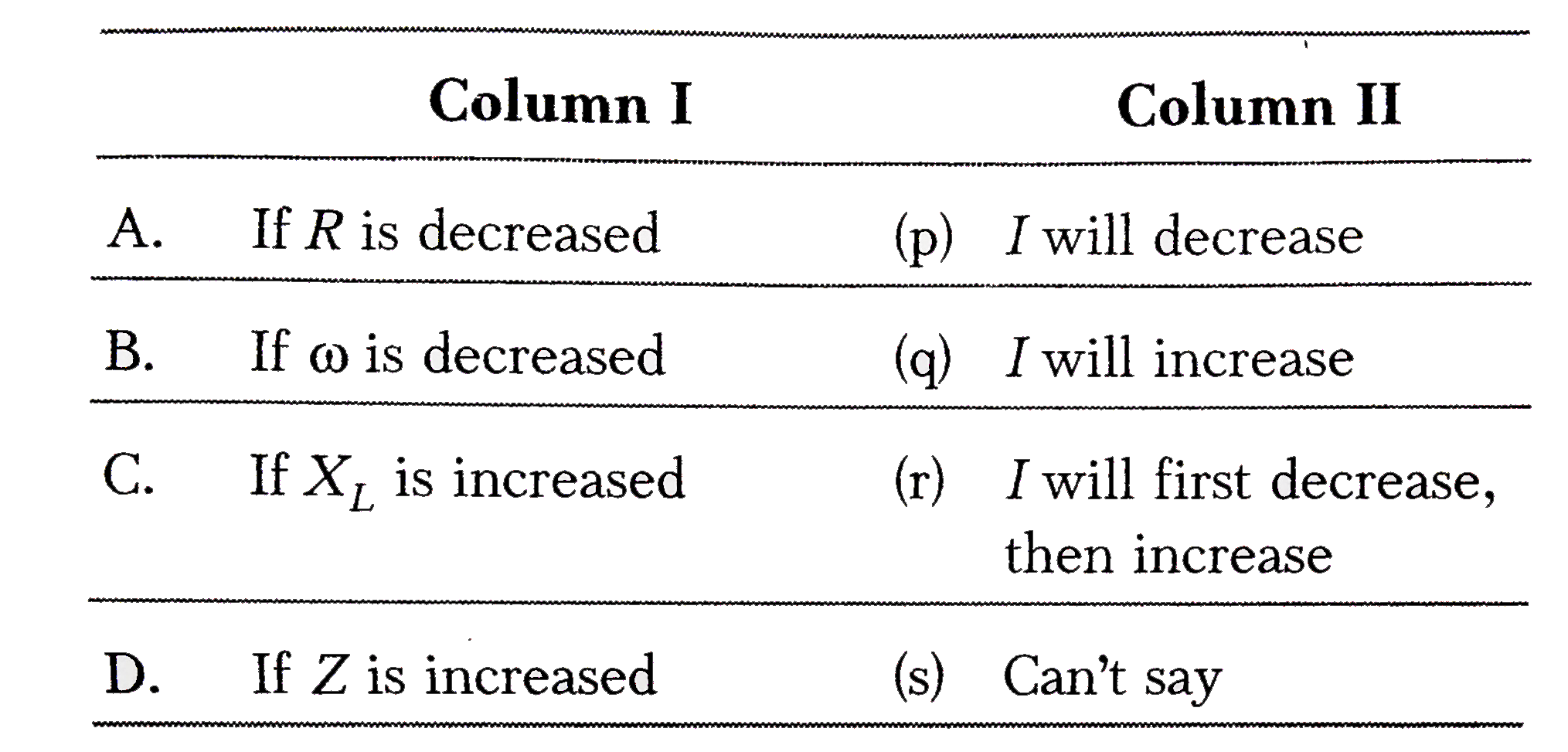Consider three quantities: x=Eb,y=1√μ0ε0,andz=lCR.
Here , l is the length of a wire , C is the capacitance , and R is a resistance. All other symbols have usual meanings. Then
xandy have the same dimensions.
xandz have the same dimensions.
yandz have the same dimensions.
None of the above three pairs have the same dimensions.
The correct Answer is:A, B, C
To solve the problem, we need to determine the dimensions of the three quantities x, y, and z given in the question. Let's analyze each quantity step by step.
Step 1: Determine the dimensions of x=Eb
Here, E represents electric field strength, and b represents magnetic field strength.
1. Electric Field E:
- The electric field E is defined as force per unit charge. The dimension of force is (F)=(M)(L)(T−2) and the dimension of charge is (Q).
- Therefore, the dimension of electric field E is:
(E)=(F)(Q)=(M)(L)(T−2)(Q)=(M)(L)(T−2)(Q−1)
2. Magnetic Field b:
- The magnetic field b (or magnetic flux density) is defined as force per unit charge per unit velocity. The dimension of velocity is (L)(T−1).
- Therefore, the dimension of magnetic field b is:
(b)=(F)(Q)(v)=(M)(L)(T−2)(Q)(L)(T−1)=(M)(T−2)(Q−1)(L−1)
3. Combining the dimensions:
- Now substituting the dimensions into x:
(x)=(E)(b)=(M)(L)(T−2)(Q−1)(M)(T−2)(Q−1)(L−1)=(L)(T−1)
- Thus, the dimension of x is (L)(T−1) (which represents velocity).
Step 2: Determine the dimensions of y=1√μ0ϵ0
1. Permeability μ0:
- The dimension of permeability μ0 is given by:
(μ0)=(F)(Q2)(L)=(M)(L)(T−2)(Q2)(L)=(M)(T−2)(Q−2)
2. Permittivity ϵ0:
- The dimension of permittivity ϵ0 is given by:
(ϵ0)=(Q2)(F)(L)=(Q2)(M)(L)(T−2)=(M−1)(L−3)(T4)(Q2)
3. Combining the dimensions:
- Now substituting the dimensions into y:
(y)=1√(μ0)(ϵ0)=1√(M)(T−2)(Q−2)(M−1)(L−3)(T4)(Q2)=1√(L−3)(T2)=(L)(T−1)
- Thus, the dimension of y is also (L)(T−1).
Step 3: Determine the dimensions of z=lCR
1. Length l:
- The dimension of length l is simply:
(l)=(L)
2. Capacitance C:
- The dimension of capacitance C is given by:
(C)=(Q)(V)=(Q)(E)=(Q)(M)(L)(T−2)(Q−1)=(M−1)(L−2)(T4)(Q2)
3. Resistance R:
- The dimension of resistance R is given by:
(R)=(V)(I)=(E)(Q)(T−1)=(M)(L)(T−2)(Q−1)(Q)(T−1)=(M)(L)(T−3)(Q−2)
4. Combining the dimensions:
- Now substituting the dimensions into z:
(z)=(l)(C)(R)=(L)(M−1)(L−2)(T4)(Q2)(M)(L)(T−3)(Q−2)=(L)(L2)(M−1)(T−4)(Q−2)(M)(L)(T3)(Q2)
- Simplifying gives:
(z)=(L)(T−1)
- Thus, the dimension of z is also (L)(T−1).
Conclusion
All three quantities x, y, and z have the same dimension of (L)(T−1), which represents velocity.
- The electric field E is defined as force per unit charge. The dimension of force is (F)=(M)(L)(T−2) and the dimension of charge is (Q).
- Therefore, the dimension of electric field E is:
(E)=(F)(Q)=(M)(L)(T−2)(Q)=(M)(L)(T−2)(Q−1)
- The magnetic field b (or magnetic flux density) is defined as force per unit charge per unit velocity. The dimension of velocity is (L)(T−1).
- Therefore, the dimension of magnetic field b is:
(b)=(F)(Q)(v)=(M)(L)(T−2)(Q)(L)(T−1)=(M)(T−2)(Q−1)(L−1)
- Now substituting the dimensions into x:
(x)=(E)(b)=(M)(L)(T−2)(Q−1)(M)(T−2)(Q−1)(L−1)=(L)(T−1)
- Thus, the dimension of x is (L)(T−1) (which represents velocity).
- The dimension of permeability μ0 is given by:
(μ0)=(F)(Q2)(L)=(M)(L)(T−2)(Q2)(L)=(M)(T−2)(Q−2)
- The dimension of permittivity ϵ0 is given by:
(ϵ0)=(Q2)(F)(L)=(Q2)(M)(L)(T−2)=(M−1)(L−3)(T4)(Q2)
- Now substituting the dimensions into y:
(y)=1√(μ0)(ϵ0)=1√(M)(T−2)(Q−2)(M−1)(L−3)(T4)(Q2)=1√(L−3)(T2)=(L)(T−1)
- Thus, the dimension of y is also (L)(T−1).
- The dimension of length l is simply:
(l)=(L)
- The dimension of capacitance C is given by:
(C)=(Q)(V)=(Q)(E)=(Q)(M)(L)(T−2)(Q−1)=(M−1)(L−2)(T4)(Q2)
- The dimension of resistance R is given by:
(R)=(V)(I)=(E)(Q)(T−1)=(M)(L)(T−2)(Q−1)(Q)(T−1)=(M)(L)(T−3)(Q−2)
- Now substituting the dimensions into z:
(z)=(l)(C)(R)=(L)(M−1)(L−2)(T4)(Q2)(M)(L)(T−3)(Q−2)=(L)(L2)(M−1)(T−4)(Q−2)(M)(L)(T3)(Q2)
- Simplifying gives:
(z)=(L)(T−1)
- Thus, the dimension of z is also (L)(T−1).
Topper's Solved these Questions
- DIMENSIONS & MEASUREMENTBOOK - CENGAGE PHYSICS ENGLISHCHAPTER - DIMENSIONS & MEASUREMENTEXERCISE - Multiple Correct
2 Videos
- DIMENSIONS & MEASUREMENTBOOK - CENGAGE PHYSICS ENGLISHCHAPTER - DIMENSIONS & MEASUREMENTEXERCISE - Linked Comprehension
3 Videos
- DIMENSIONS & MEASUREMENTBOOK - CENGAGE PHYSICS ENGLISHCHAPTER - DIMENSIONS & MEASUREMENTEXERCISE - Subjective
31 Videos
- CENTRE OF MASSBOOK - CENGAGE PHYSICS ENGLISHCHAPTER - CENTRE OF MASSEXERCISE - INTEGER_TYPE
1 Videos
- FLUID MECHANICSBOOK - CENGAGE PHYSICS ENGLISHCHAPTER - FLUID MECHANICSEXERCISE - INTEGER_TYPE
1 Videos
Similar Questions
Consider three quantities (x= E/B, y= (sqrt(1/((mu_0)(epsilon_0)))) and z=(1/CR)'. Here, l is the length of a wire, C is a capacitance and R is a resistance. All other symbols have standard meanings.
View SolutionDimension of 1μ0ε0, where symbols have usual meaning, are
View SolutionThe dimension of e2/ε0hc (here symbols have their usual meanings) are
View SolutionWhat is the dimensional formula of 1μ0ε0 where the symbols have their usual meanings?
View SolutionIn a series L-C-R, AC circuit assuming that symbols have their usual meanings match the following two columns.

View SolutionL, C and R represent the physical quantities, inductance, capacitance and resistance respectively. The combination(s) which have the dimensions of frequency are
View SolutionL, C and R represent the physical quantities inductance, capacitance and resistance respectively. The combinations which have the dimensions of frequency are-
View SolutionL, C and R represent the physical quantities, inductance, capacitance and resistance respectively. The combination(s) which have the dimensions of frequency are
View SolutionWhich of the following pairs have the same dimensions ?
(L = inductance , C = capacitance , R = resistance)
View SolutionIn a ΔABC, if b=(√3−1)aand∠C=30∘, then the value of (A-B) is equal to (All symbols used have usual meaning in the triangel.)
View Solution
